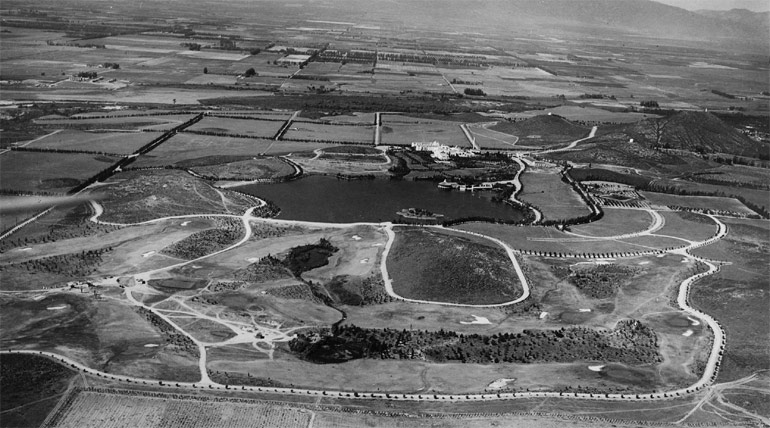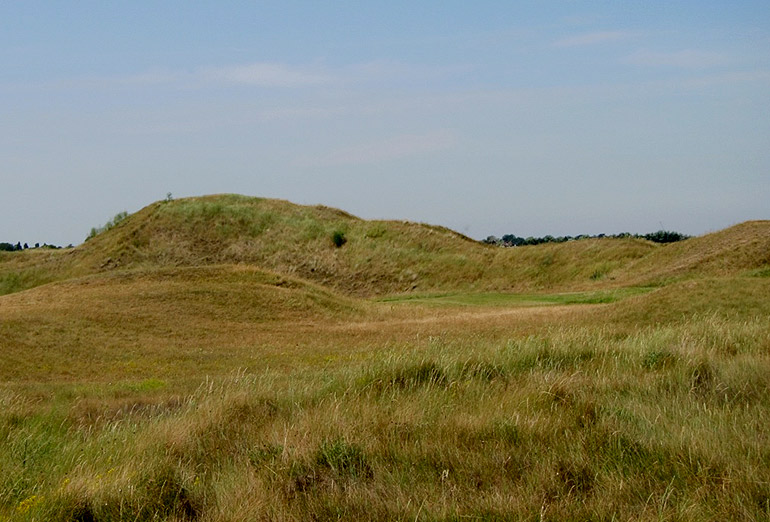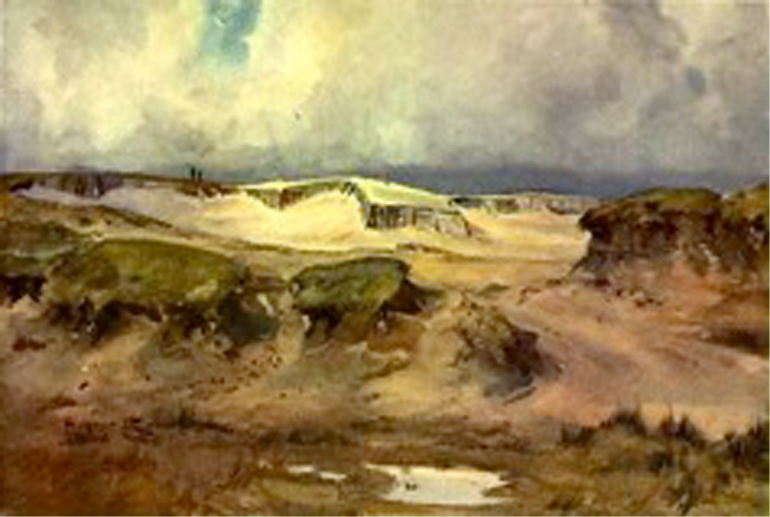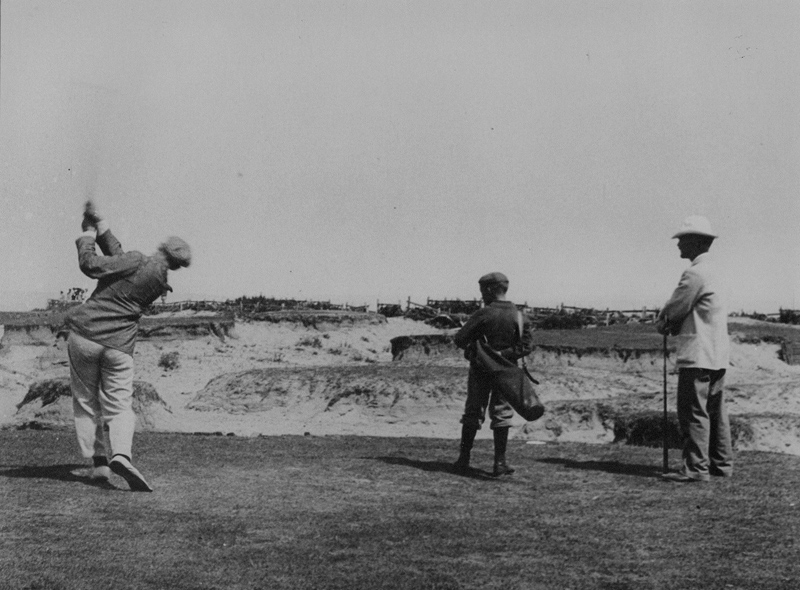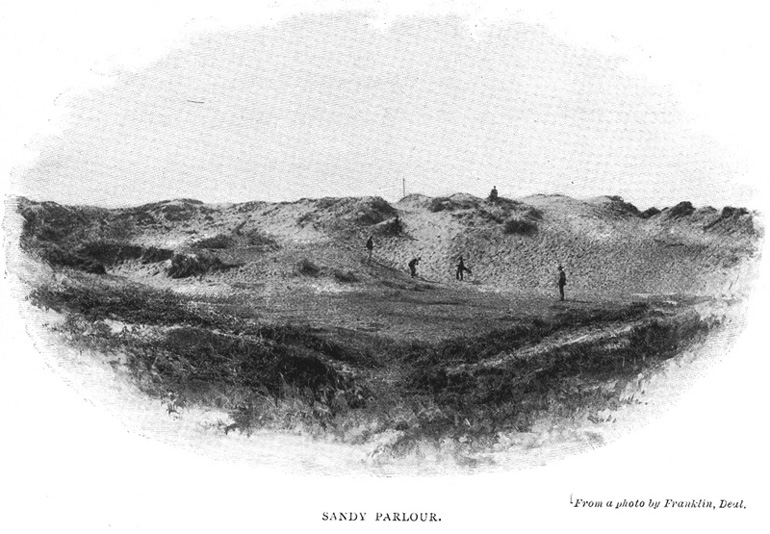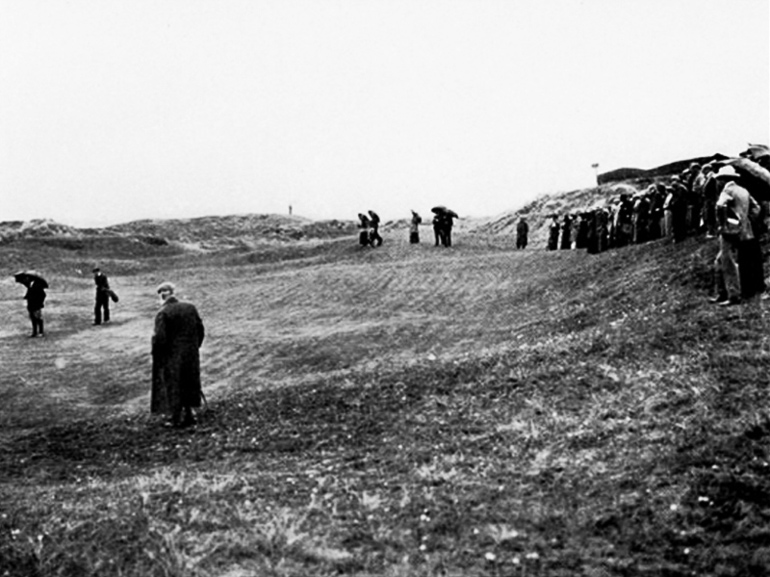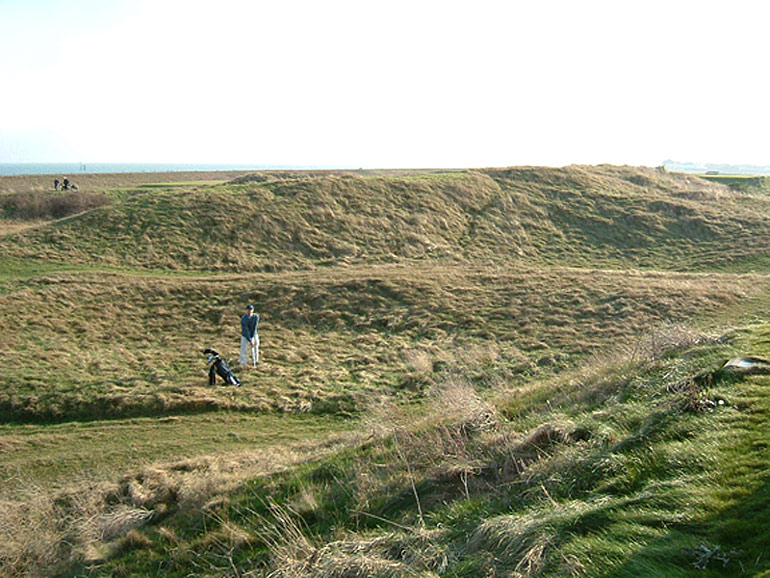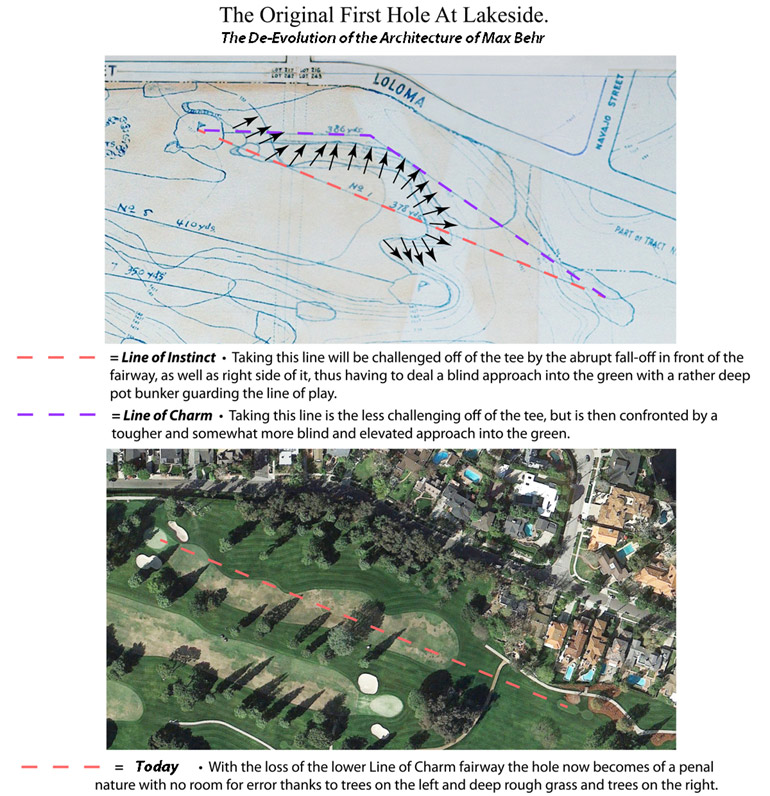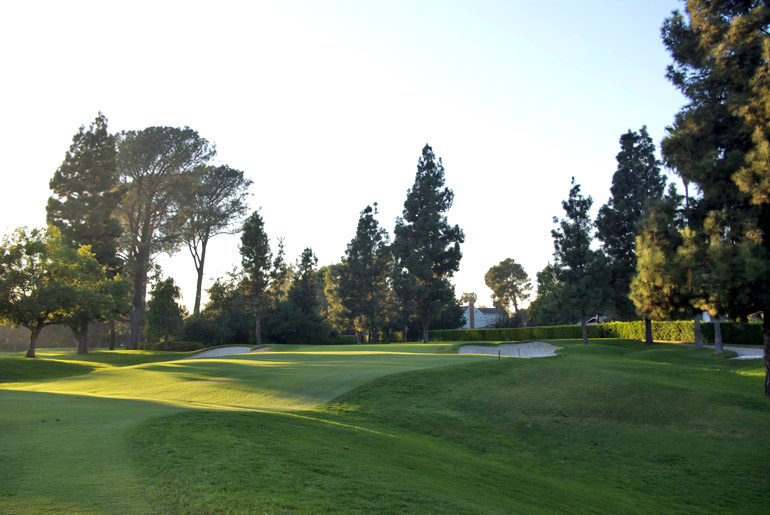Interview with Tommy Naccarato
page 2
12) Talk about John Duncan Dunn and Lake Norconian. What is left of this course and where would it rank in Southern California if still there today?
The Norconian was, without doubt, John Duncan Dunn’s masterpiece, but where it would rank in Southern California today is anyone’s best guess. It sure looked compelling as a golf course though!
JDD was given an almost Fazio-like budget (for the day) which provided him the resources to create a series of ponds and creeks which were laid out over the club’s back nine and feed the course’s irrigation ponds. It had a masterfully designed pumping system that circulated the water to and from the high and low points of that back nine. Today it’s a no longer existing golf course located under a community college and several houses and there are very few people that live in that area that realize how cool this place was at one time. All that remains is the site of the 17th green and 18th tee and part of the 13th green up on a hill behind the Naval buildings.
What’s really sad is that the entire resort and its buildings of incredible largesse still stand. They have been sentenced to die a slow death by the State of California, which does not want to take care of them. Ultimately, the main blame has to fall on the shoulders of the very opulence that eventually brought down its founder, developer and visionary, Rex B. Clark, when he couldn’t convince his father-in-law, the powerful and famous newspaper publisher and philanthropist, James Scripps, to cut loose with more needed funds to build the Spanish-styled clubhouse he had planned out for the golf course. And things got worse when the elder Scripps and his daughter found out about Clark’s mistress in Pasadena!
The Norconian Grand Resort Supreme (its original name) would eventually become a minimum security prison for the California Rehabilitation Center in 1960, and it would find further infamous fame when it served as the main inspiration for the Eagles 1976 hit rock album, The Hotel California. The album features both the album’s title track as well as the song, The Last Resort, and it leaves a very eerie reminder of what once was and will never be again. The Eagles’ Don Henley described the album as a metaphor for the perceived decline of America into materialism and decadence – which is ironic in that it’s just like John Duncan Dunn’s and Rex Clark’s greatest masterpiece.
There is hope that Norco’s mayor (and friend) Kevin Bash can convince the State to turn the property over to the city of Norco, and if successful that he can find some magnet to rebuild this magnificent palace into a conference center. Right now, its a million-miles from home in thinking golf could included in this. But I’m happy that I’ll be included in the discussion when it does.
Before I go on any further, I promised someone I would get something in here:
El Niguel Country Club!
O.K. back to our regularly scheduled programming…… (Somebody owes me a Soundside!)
13) You’ve become an expert on bunkers over the last several years. Describe a few of your favorites, both in terms of placement and aesthetics.
Bernard Darwin probably serves as the best source of my love for hazards of great character. When I first read this, it was like poetry, after all, who better a writer on golf then Darwin, right?!?!?
He wrote, “They are to be found on links of undoubted eminence, and were found on many more till they were literally hacked and hewed out of existence by the niblick shots of their infuriated victims. Moreover, say what we will, they are rather entertaining, and the very fact that a serious error will almost ruin us gives a poignancy which is lacking in any but the most desperate of sand-pits; we trifle pleasurably with our terrors and snatch a fearful joy…..”
When I had first read this, I was like, “He was writing about me 49 years before I was born!”
While that is a romantic notion, honestly, what an incredible view Golf Courses of the British Isles has given our generation and generations yet to come!
These are not in any particular order, and some of them aren’t really bunkers, but more just hazards and features of great character. Most of them I’ve never seen, just dreamt about playing:
1. Majuba – Burnham & Berrow The experiences of the Boer War must have had an very large impact on many in Great Britain. Most certainly carrying over into the fear of their golf hazards.
Two hazards on the Old Course named after the Kruger’s; a British surgeon named MacKenzie who, formed some insightful opinions on how golf holes should be designed by use of camouflaging tricks he had seen in the field of battle and this aptly named peak at Burnham & Berrow which reminded players, veterans of the Boer War of hilly peak in Transvaal which had been used by the enemy to take the high ground and then hid in its tall grasses and bushes and picked off the invading Brits one by one as they tried to take Majuba Hill.
Today, B&B’s Majuba no longer exists, another victim of the defeat of the blind, one-shot hole variety, but many of my favorite Golden Age architects were the one’s that took these holes out of play. One can’t help to think there is something to that!
2. “The Maiden”
“The Maiden” at Royal St. George’s aka Sandwich. Like The Sandy Parlour at nearby Deal, its dune while still in use in a much different fashion then it was originally conceived.
The Maiden was another “sleepered” and ugly looking affair. The demise of the hole was the result of someone being killed by an errant approach shot on the at the 5th.
Bernard Darwin wrote:
“ We will then avoid a painful controversy and tee our ball before the famous ?Maiden.’ Few bunkers have a more infamous reputation then this Maiden, but the new-comer to the Sandwich of to-day will think that she had done little to deserve it. There stands the Maiden, steep, sandy and terrible, with her face scarred and seamed with black timbers, but alas! we have no longer to drive over her crown: we hardly do more than skirt the fringe of her garment. In old days the tee was right beneath the highest pinnacle, and sheer terror made the shot formidable, but the tee-shots to the fifth endangered the lives of those driving to the sixth, and the tee had to be put far away to the right. The present Maiden is but a shadow of its old self, and the splendour of it has in a great measure departed.”
You think about the Maiden and what it would look like today, after it has become nothing more than an echo, sitting there silently. It’s a crime in my eyes – that history is sitting right there and that it will be lost forever when it is just simply forgotten.
3. Westward Ho! –
This one should be a Ran favorite, if it isn’t one of my all-time favorites. Most of us know Ran’s love for this magnificent golf course located in the West country. There is a great many legendary features there as well, like the Great Sea Rushes and this
4. Death or Glory _ Here’s another one that I’ve never been to, but can only imagine how imposting of a bunker it could be, and that’s the short “Kick and a spit”
Darwin wrote on Northwood’s 8th: (I believe it has now been re-routed as the 10th and the hole is of course a shadow of its former self)
“We walk the very brink of destruction without knowing it, for there is nothing particular to mark the drive; we have but to hit moderately straight, as it appears, over a flat and somewhat muddy space towards a bunker in the distance. then as we walk up to the ball the full horror of our situation bursts upon us. We have to pitch over a bunker straight in front of the green, but that is mere child’s play, and only the beginning of our task. On the left-hand side, eating its way into the very heart of the green, is another bunker, very deep and shored up by the precipitous black timbers, and the very slightest pull of our approach shot will land us in it….” He then closes with “….if only there are enough difficulties to strike terror into the soul.”
Someday, I hope to see it and convey amongst the members of that North London club that they have gold laying out there, a short distance from their clubhouse.
My favorite sand hazard in the modern scheme of things, undoubtedly the 10th hole at Friar’s Head. I love the dune; the partial blindness and most how its surrounded by more dunes–all of them natural. They found that dune there! Really, its like modern day Maiden or Sandy Parlour for me. It embraces all that is great with the bling/partially blind sandy dune of a golf hole. I can hardly wait to get to the green to see where my ball ended up on that massive green of fun!
14) What does the loss of a hole like Sandy Parlour do to the soul of golf? Anything? Nothing?
I’m a great believer that there was a certain mystique of a blind one shot hole. At least the one’s that were aptly named. In fact, how many holes nowadays are named because of reputation? I’m not sure where they got their names either; at least I’ve never seen anything written in the myriads of books I’ve read over the years and there were many blind one-shotters in England during the heydays of Horace Hutchinson – all of them of reputable terror.
These weren’t strategic golf holes as much as they were short holes – fun match play holes – that would get you out of your comfort zone. I would think that’s why they became so reputable. When you see old pictures of competitions being played on these holes, the dunes are lined up with people watching, so surely there must have been some entertainment value to them!
With Sandy Parlour and all of the others, they were like leap of faith shots. There is a place for those in certain situations, especially when some wild natural and menacing wind blown feature calls for it. With Sandy, from the looks of it, you had to get the ball on the right part of the slack (back of the dune) in order for it to bound onto the green, literally running into a contour which would direct the ball to the back of the pin. This doesn’t leave many pin placements that are as exciting as the perfect shot at the target and hopefully by the time you get to the top of the dune to see where you ended up. There were also the many stories of the caddies who, in search of a great tip, put the ball in the hole, which left a certain amount of doubt – “did I or didn’t I!?!?” – while everyone in the pub was laughing their ass off as they knew the truth while having drinks on the poor chap!
So the loss of a hole like Sandy Parlour rips right at the Soul of Golf, absolutely! As the Brits would say, It was a bloody good time!
Perhaps the hole, which could be restored in its entirety, could become an alternate hole to be played from time to time. the thing is to get the club interested in their history, show them how much fun the sport is meant to be and that when playing difficult holes like this, you may rejoice to live to see another day.
Evolution of the Sandy Parlour Sand Dune
From Horace Hutchinson’s British Golf Links, the earliest image I know of The Sandy Parlour.
Over time, the dune is left to exist without maintenance. You can see the once common sand areas have take on a more natural look and persona with the various grasses one finds on true links.
After the turn of the century, the dune maintenance became very common place. the dune was stripped of its grasses, leaving just partial scrub just enough to keep it natural looking. Sleepers were added to shore up the top of the dune, which as you can see had dropped rather dramatically.
Not long after that, the sleepers started to fail, and the dune got its further “ugly” and intimidating look.
The current Sandy Parlour with GCA’er Noel “Naffer” Freeman standing in to show scale. The tee for the new fourth was cut into the dune and its fill was purportedly used to build the new 4th hole which plays to the right of this picture.
With its contours clearly being shown, it is not hard to see that most if not the entire green is still there in its entirety. Romantic notions of a “raw” Deal still exist.
15) You’re a long time panelist for Golf Week magazine. What do you look for when evaluating a golf course?
I like the fact that the two categories of Classic and Modern are separated. It makes a huge difference in rating. There are so many things that go into evaluation of a golf course, some of which are emotional and may not be covered by the “conventional rules,” but routings and green complexes are at the core of what make golf courses great or not so great. How a green is defended and not over-cooked with hazards that aren’t attractive in a golf sense.
16) Discuss Rustic Canyon.
It was heralded as a great inexpensive course when it first opened and it remains wildly popular to play. Yet, now it has now fallen off Golf Week’s Modern Top 100 Course list. Both Friar’s Head, Rustic Canyon are very special places for me simply because of the great architecture and what my friends gave of themselves to build these magnificent places and how they will be viewed in the many years to come.
With Rustic, I consider it home even though it’s almost an hour and twenty minutes from my front door. I think it’s important for all of us, if we are true golfers, to have a relationship with a course that brings us to an emotional center….where each hole challenges us….where we look forward to each shot time and time again….and where we feel at home, as I do at both Rustic and Friar’s Head. For me, these are the places where my problems seem to just fade away and I am most at peace.
To give you a better sense of what I’m talking about, let’s take for instance the tee shot at Rustic’s 14th, which is incredibly tough for me, a low ball hitting shortknocker. It just gets into my comfort zone and while I can hit the ball with carry usually with no problem on any of the other holes at the same distance, this hole just sets up perfectly to screw with me! I love that about a golf hole, because, honestly, it keeps me looking forward to the day I can beat that challenge. There are other holes at Rustic that I feel take architecture to a new but old dimension – remembrances of shots or challenges similar to the Old Course and I would imagine Augusta in some spots. It also helps that while Rustic was being built, I had the good fortune to be out there a lot to see the effort that Gil, Geoff and Jim put into this place. It was an experience.
As far as where it rates, well obviously there are some raters and panelists that think differently than I do. Ultimately, I look at Rustic not being in Golf Week’s Modern Top 100 Course list as proof of a flaw in the rating system and it was a bitter pill to swallow because I know what is there architecturally.
17) It’s no secret that Friars Head is one of your all-time favorite designs. What makes it special in your eyes?
With my thoughts that routing and putting surfaces being the main thing I like looking for in architecture, it isn’t too hard for someone that knows Friar’s head to concur that the routing and putting surfaces are off the charts excellent.
Most everything I’ve read from the great architect’s leads to the two facts: That most great golf holes are best looked at from the green back to the tee, and the importance of defense of the green.
At Friar’s Head you literally have a host of options off of every hole for that matter, even every tee, including the front tees–and I have played them all there– that present a great challenge to where the pin is set that day; you literally have to tack your way to the hole no different then in chess where your thinking one, two and three shots ahead, It works just not from not just the personal challenge of low score that is so adamant in the mindset today, but even better in a match play way of things- you know when your opponent has put himself in a difficult position, or, a better one. You just know when the tide changes in and out of your favor. For me, that’s great golf!
But to get there, it all has to start with the architect routing of the course and how its going to play for every form of golfer. Not just one-type; how he identifies the natural features and works off of them, and sometimes even creating something that wasn’t even there. He has to be able to identify the possibilities.
At Friar’s Head, Bill Coore did exactly that knowing that had to live up to the quality of the other courses that existed in that area. A pretty ballsy move when you think about it. The thing that is so obvious is that he managed to find a way to play golf on and off the dune line that separated the flat potato field from the bluff’s edge over-looking the Long Island Sound. To make it interesting, he took four, three shot holes on and off of the dune–used their length while maintaining the natural character of the dune and it’s surroundings with all of its quirks and balances to add to the mix. As routings go, they might not get any better then this! Add the green complexes to the mix, and I mean a wide array of ways to get to the pins, and its something worthy of great study for every form of player or even a serious golf designer. Imagine being the one getting to create that? The responsibility that comes with a site like that!?!?!
Not to leave another important–at least important aspect for me, the self-frustrated artist, well, could one paint a more prettier picture of a site that was previous to it being both a sand-scraped bluff and a former potato field? It’s an architect’s job to use that canvas as an artist for use for golf, to use grasses , sand and shaping no different then he was applying the many various spectrums of color to create; he has to be inspired by the features of that property. Let’s face it: Is he going to use a potato field or wild sand dunes which to work with for thought! What they created was and is a portrait that describes Golf in our times and it has set itself apart in that quest.
So, when I go out and see this golf course in this majestic setting I do know that I’m experiencing something I feel is the best of its nature. That’s what Friar’s Head means to me.
18) As a student of golf course architecture, to which five books do you find yourself most often referring?
• George Thomas’ Golf Architecture In America
• Roger Wethered & Tom Simpson’s The Architectural Side of Golf
• Robert Hunter’s The Links
• Horace Hutchinson’s British Golf Links
• Bernard Darwin’s Golf Courses of the British Isles
These I feel are the best studies of classical values you can find, although I would suggest that any serious student of golf course architecture should read the various articles written by Max Behr. They are definitely hard to read for some, but if you take the time and dissect them, you will find that they embrace ever true principles of the art, as well as every human element that goes with it.
19) Max Behr is one of your all-time heroes yet most golfers today haven’t even heard of him. What fascinates you about him?
Max was the golfer’s golfer. As the son of a wealthy industrialist, he lived a life in golf, literally learning to play at very nearly the onset of the sport’s introduction in America in the 1890’s. The family home was in New York, and they would escape to the “country” in Morristown, New Jersey where memberships at Morris County Country Club and then eventually Baltusrol allowed Max, who eventually played for the golf team at Yale University, to further tune his game.
After graduation, Max saw the need and became the editor and publisher of Golf Illustrated. It was here that he found a perfect pulpit from which to preach; not just on the romantic notions of golf, but also on the need to protect the very soul of the sport itself, including scathing indictments of the USGA, handicapping, the rules and general play. Anything that was taking the sport away from its very soul was fair game for Max’s indictments!
He married the daughter of another wealthy New Yorker and was living a life of playing tournaments and writing about golf. And he was an accomplished player, having finished as the runner-up to Jerome Travers at Garden City in the 1908 USGA Amateur Championship. In 1918, his beloved wife Evelyn suddenly passed away from the contacting of Scarlett Fever, leaving a distraught Max with the responsibility of raising alone his daughter and son.
Whether it was the effects of Evelyn’s death or simply a need for a change of surroundings, Behr sold his interests in Golf Illustrated and uprooted his family and came to Los Angeles in 1919. He immediately immersed himself into tournament play in and around the Los Angeles area clubs and courses and becoming a member at both the Wilshire and Pasadena Country Clubs.
His interest in Golf Architecture flourished in Los Angeles, where he both wrote about and designed golf courses. I think he was somewhat more of a tyrant on golf, and I suspect that more than a few knew that he was more of a Hun when it came to principles. He was a Golfing Extremist, and that’s probably why I am so fascinated by him, ha!
20) Tell us three of his favorite design principles and why modern architects should read and study his work.
Obviously, and one of Max Behr’s more misused and misunderstood terms is “The Line of Charm.” From an artistic and strategic standpoint, the term is only half the principle and I’ve seen often on GCA in particular, one of them who actually thinks, and I’m going to quote him, “Its all about the Line of Charm!”
People like this should stay away from making these kinds of statements. You see, in Behr’s term, you can’t have a “Line of Charm” without a “Line of Instinct“ and it’s that “Line of Instinct” that is often misunderstood as being the “Line of Charm.”
The Line of Instinct is the line between you and the golf hole that is broken up by natural lines of hazards, hills, bunkers, creek beds, folds in the land, etc. It’s where the natural and picturesque art of a golf hole lies and to challenge it is risky.
The Line of Charm is the safe route to the hole, which takes you away from the natural hazards and leaves breathing room, albeit with a more stringent task of getting on to the green and into the hole.
Another Behr tenant is Width, that a golf course should have the least amount of boundaries and out of bounds as possible. He characterized golf as a “sport,” while calling baseball, football, tennis, etc., “games,” simply because of the fixed lines and boundaries of the latter. He believed in the Sportsman aspect of golf, no different than hunting, fishing, etc. He was willing to go to the death mat to prove his point, and did so often with more scathing indictments of the rank and file. And he despised the use (or overuse) of sand as a hazard in unnatural places where exposed sand couldn’t naturally occur. Go play a Max Behr course and you’re going to come away smitten with the land and what he did with it despite the addition of thousands of palm and pine trees and cost to maintain rough which has been added on to these courses with little regard to or understanding of the fun and brilliant architecture. We are talking about massive amounts of earth moved to create different forms of play, and usually one or two rather well placed bunkers to really make you understand the strategy, thought and, most, CHALLENGE.
So with Line of Instinct/Line of Charm, Width, fewer and more well thought out bunkers, combined with a keen use of the land that emulated how the great links courses of Great Britain played (more specifically, The Old Course), you have the architecture of Max Behr. Something that is in most architects’ cases completely unreasonable and the thoughts of a lunatic who is dead. But if you would take the time to actually see Behr’s work with these principles in mind, you would see the very nature of what creating great golf was all about in Max’s terms. The courses were magnificent, but unfortunately we can now only see what’s left of them.
Lakeside’s old 1st, now 10th with its drop-off alternate fairway that is right. If you look closely, you can see where the original bunker has been filled in the immediate rough area.
21) Overall, do you think modern architects do a good job following the time proven design tenets as espoused by the Golden Age architects?
Some yes, most no.
It pains me to see where some modern architecture has gone in the commercial aspect of things. In some ways, its like building architecture today. Drive down or around any neighborhood built in the last 40 years and you’ll see no architectural style or influence or substance. Nothing inspires. Its the same as an architect that uses goofy greens and overuses bunkering in the sake of looking good–only it looks like crap.
During the housing boom of recent years past, I started seeing a lot of houses built with some amount of Craftsman or Spanish or Moor-like influence. Only get inside and you could see that it was all smoke and mirrors. The thought was there, but it just didn’t quite get it done.
With Golf Architecture, its much the same. You have a few architects that have embraced a style; have literally used it in the building of their own works (How much more Craftsman can you get!?!?) and prove it with interest thats in the ground. It takes more then one guy to design and build a golf course–at least a great one. Its no different then if I wanted to do a major electrical job on my own. Somewhere, I have to rely on help of others to get the job done in a Craftsmanlike and safe manner. There are only so many that realize this.
Recently, a rather well known Senior Architect of a well-known commercially successful design firm who is destroying a classic George Thomas course told me to “Get over it, Golf is for the Living!”
Its here you have to wonder why this person is even allowed near the gates of that club.
The lack of integrity going on is because they don’t know how to understand these classic courses and want to change on the premise it didn’t work for the +/-85 years that the course amassed its reputation. I’m of the opinion that Golf is not for the Ignorant!
I do believe that if more commercially successful architects designed courses the way guys like Don Mahaffey like to maintain them, the sport would be in a much more healthy state. The return of gang mowing and less complex irrigation systems which drive the cost through the roof has got to go. Courses would be more affordable to maintain, which means less cost to play. Its not just that people don’t have the money to play, they don’t want to spend the kind of money these courses are asking for. Its making the sport less and less attractable. You want people to tee it forward? Well how about some forward thinking first!
You’ve got guys like Adam Jessie over at St. George’s who with Gil and his masterplan, magically transformed a treed-nightmare that Devereaux Emmet would have never recognized into the wild roller coaster ride that it is. Discovering golf like that is fun and exciting!
22) Please share with us your thoughts on Tom MacWood who passed away unexpectedly in August, 2012 at the age of 54.
Without a doubt, the best of us as far as research. No one can even compare. Not even close and I’m not saying this because he is gone, but because it’s a fact. He could literally take all your thoughts and turn them over and dump them out, because he already knew what you had found plus more. My respect for Tom was immeasurable.
The regretful thing was I was not speaking with him at the time of his death due to a matter of opinions, which is sad and ironic in light of how much I in fact respected Tom and what I wrote earlier about putting your differences aside and moving on. In any event, about two weeks before he died, I contemplated calling Tom to catch up and put my past feelings aside. I mean, after all, you have to practice what you preach. Sadly time got in the way and I didn’t call and now it’s something I will regret for the rest of my life. I’ve read the following email that Tom wrote to me and Tony Pioppi every day since I found out about Tom’s passing:
“I don’t know where you gents are regarding my hoax, but I have no hard feelings toward your recent position, and hope to share info in the future.”
You see, Tom was one that could overlook the childlike issues some of us had, no matter how harshly we struck out at him. His email to me was proof of it, especially after some of the things he had endured here on Golf Club Atlas by the way of others. He took a lot of hits here on his credibility, which I know I could never have taken as well for I surely would have regressed into a shell. But Tom was willing to do the right thing by putting his feelings aside and walk away friends first and last. We never met in person – something more to regret – however, we conversed on the phone regularly for years. We shared the same passion. We assisted each other with tips and information of collections and where to find things. I looked for him and he looked for me. We made a pact to find out why William Watson was so elusive as an architect in pictures and the like. Tony Pioppi was part of this too and he can attest to Tom’s abilities and information; proof of what he found was always mind-blowing.
Tom’s untimely passing makes it all the more difficult to deal with knowing that stupid and unnecessary infighting hurt this great website, as well as hurt our cause in finding out more about these fantastic golfing personalities that preceded our generation, and for that, I look at myself in the mirror and readily accept the blame. There are others that need to realize that and do the same.
Amen!
23) Any concluding thoughts (and I am sure the answer is yes!)?
I was talking with the talented architect, Jim Urbina, about this interview and he suggested to me he “would love for these guys to know your passion, not just for architecture, but for Golf in general. They need to hear it.” And that really blew me away.
You see, when I was participating on this and all of the other websites, I had been very caustic at times. I look back at some of my old posts and ask myself how on earth I could have said some of the things I said. I’m not a mean person at all; I’m just driven to see architecture succeed on the grandest of levels and hopefully make some life-long friends while doing it. But it’s easy to understand the dissension, because the internet is strange like that. We talk by writing, but we can’t hear the intonation in each other’s voices and see through each other’s eyes what we might actually be thinking or where it’s coming from. There are many big name and very successful architects, club committeemen, employees of the governing body and even the director of the ASGCA that have taken me to task for this passion and rightfully so. What I think they really don’t understand is that it’s not just my passion for the subject, but my passion for Golf that’s inside of me, and, I think its inside of all of us. Our love and passion for Golf brings us so many things, and hopefully one day most, the understanding and patience with others, thus bringing us to the ultimate goal: life with no out of bounds.
THE END


